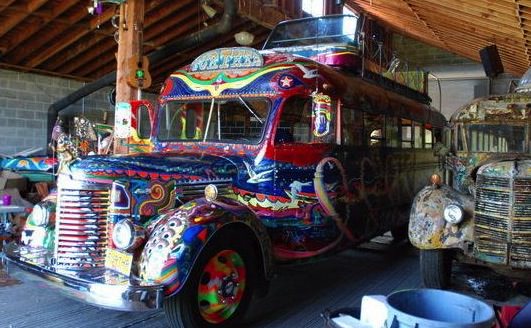When the late author Ken Kesey and his pals, the Merry Pranksters, took their psychedelic bus ride across America to visit the New York World’s Fair, the nation was mourning President John F Kennedy’s assassination and the Grateful Dead were not yet a band. And, perhaps most importantly, LSD was still legal.
For their trip, they rode in a bus painted with brightly coloured swirls, outfitted with a sound system and emblazoned with the word “Further” as the destination. Sporting short haircuts and red-white-and-blue sport shirts, they had plenty of marijuana and LSD.
“The whole psychedelic scene came from that bus trip,” said Kesey’s son, Zane, who as a three-year-old helped paint the bus and waved a tearful goodbye as it drove away.
Now, on the 50th anniversary of the journey, Zane Kesey has launched a campaign on the crowd-funding site Kickstarter, looking for a few good modern-day Pranksters to contribute $200 each for a chance to do it all again, though on a different bus. And without the LSD.
His father, who wrote the seminal novel One Flew Over the Cuckoo’s Nest, had been a guinea pig for government tests of the mind-altering drug and shared the experience at a series of parties at his home in the hills above Stanford University that became known as the Acid Tests.
They featured a local bar band called The Warlocks, which turned into the Grateful Dead. After the trip, the bus became the centrepiece as the Acid Tests went on the road.
After a road trip to New York with his parents and wife, Faye, to see the stage production of Cuckoo’s Nest, Kesey thought it would be fun to get his friends to do another cross-country ride that would serve as the basis for a movie, with LSD at the centre, his friend Ken Babbs said. It soon became clear that the family station wagon would not be big enough, so Kesey sent a friend up to San Francisco to check out an ad for an old school bus converted into a camper, with bunks and a kitchen, Babbs said.
“I think it was $1,500,” he said.
During the journey, the bus was pulled over by a policeman in California, got bogged down in an Arizona river and lost one of its crew to a bad trip in Texas. In Louisiana, the Pranksters jammed with a piano player in a New Orleans bar. In New York, they rolled through the streets playing their homemade music and met the poet Alan Ginsberg, who took them to a Connecticut estate to meet the LSD guru Timothy Leary.
The movie never materialised as the new art form Kesey had envisioned, a victim of the film and audio tapes reproducing at different speeds. They could not be synchronised until 30 years later with the help of digital technology. Kesey died in 2001.
Texas A&M historian Terry Anderson, author of the book, The Sixties, said the bus trip was too early to kick off the counterculture, adding that it was overshadowed by the Beatles and the signing of the Civil Rights Act the same year.
But the tapes and film gave author Tom Wolfe the material he needed for his 1968 book, The Electric Kool-Aid Acid Test, which made the trip a touchstone of the psychedelic era.
Babbs said Kesey himself never claimed to have started the psychedelic era, but he was happy to ride the wave. “We were too young to be beats, and too old to be hippies,” he said. “We were really our own thing.”
Embarking at the end of July, the anniversary trip is making no attempt to recreate the old one, and follows a more northerly route, visiting a series of arts and music festivals.
People who want a chance to get on the bus must invest $200, and pass a series of tests, answering questions such as whether they like movies about gladiators. The chosen will get a token to board the bus for a leg, and join in making a new movie.
Though not even born when the original bus embarked on 17 June 1964, Joshua Priest, 26, and Andrea Castillo, 21, of Menisee, California, are determined to get on board.
Grateful Dead fans who learned about the bus trip by reading Wolfe’s book, they learned about the anniversary expedition on Facebook and raised $400 with a garage sale. Castillo, a graphic arts student, created a series of drawings answering the questions.
“That’s what life is about: taking chances and having fun,” she said.
Agencies/Associated Press
 Canada Journal – News of the World Articles and videos to bring you the biggest Canadian news stories from across the country every day
Canada Journal – News of the World Articles and videos to bring you the biggest Canadian news stories from across the country every day



